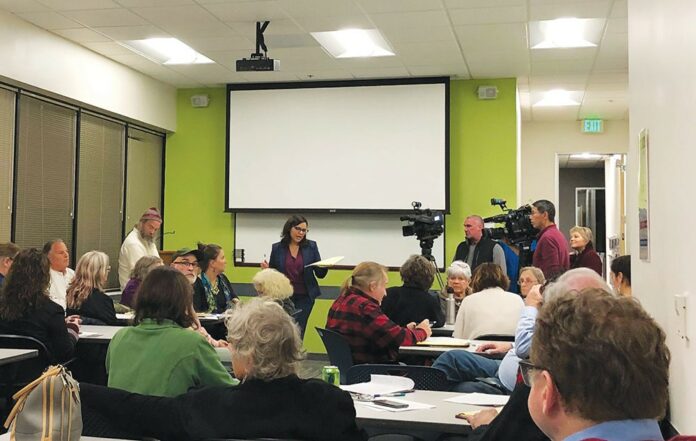Approximately 30 community members and longtime activists filled a county conference room in Petaluma to discuss possible changes due to the recent death of David Ward after an interaction with Sonoma County law enforcement officials last November.
But the Monday, Jan. 13 town hall meeting, organized by Karlene Navarro, the director of the Independent Office of Law Enforcement Review and Outreach (IOLERO), lacked a crucial attendee: the Sonoma County Sheriff’s Office.
Navarro said she had extended an invitation to the agency, but did not elaborate on why they declined to send a representative. The Sheriff’s Office did not immediately respond to a request for comment on Tuesday, Jan. 14.
On Nov. 27, Ward, a Petaluma resident, died after an early-morning car chase and struggle with the officers from the Sheriff’s Office and the Sebastopol Police Department.
After the officers hit and used a Taser on Ward, Deputy Charles Blount smashed Ward’s head against the edge of the car door.
The case drew media coverage from around the country, especially as details about Blount’s history emerged in the weeks after Ward’s death.
On Dec. 5, KQED reported on Blount’s history of allegations of excessive force and multiple uses of the carotid hold, a controversial neck restraint he attempted to use on Ward. Blount also lied about using the carotid hold during a court proceeding, according to KQED.
The Marin County Coroner’s Office, which is investigating the cause of Ward’s death, has not released its findings. The Sonoma County Sheriff’s Office has completed its internal affairs investigation of Ward’s death, Navarro said at the town hall meeting.
The law enforcement agency has said it will not release the findings of its internal review to Navarro until the Sheriff’s Office has completed a labor procedure known as a Skelly hearing, according to Navarro.
In a statement accompanying the Dec. 20 video of the incident, Sonoma County Sheriff Mark Essick condemned Blount’s actions as “extremely troubling” and announced that he issued the deputy a notice of termination.
Town hall attendees voiced frustration that the Sheriff’s Office has what they perceive as a culture of avoiding meaningful community oversight. The fact that no one from the Sheriff’s Office attended the public meeting did not help that perception.
In discussions, meeting attendees raised a wide range of concerns about the Ward case and the culture within the Sheriff’s Office that may have contributed to the event. Attendees also stressed the need to focus on changing the culture of the Sheriff’s Office rather than just pushing for changes to its use-of-force policies.
For instance, the fact that Blount remained in the Sheriff’s Office despite his history indicated to attendees that the office could have avoided the Ward case if they had reprimanded Blount sooner.
Discussions during the meeting also raised recurring tensions between Navarro and former members of the IOLERO Community Advisory Council (CAC), a group of volunteers tasked with researching policy proposals and contacting the community.
Two guest speakers booked by Navarro spoke about “community trauma healing.” But some attendees, many of whom have been actively following the Sheriff’s Office’s activities for years, noted that discussion about personal healing techniques were premature since many community members still do not trust the law enforcement agency.
Rick Brown, the former chair of the IOLERO CAC, commented on the need for community trust of the Sheriff’s Office and IOLERO.
“You talk about trusting yourself,” Brown said after one of the speakers addressed the need for self-care in the wake of trauma. “At a community level, you also have to talk about [trusting] the people who have been called on to protect you… the people who are your servants to do the work of making sure the community is safe.
“In this circumstance, that hasn’t happened,” Brown said, referring to the process of submitting a long list of use of force recommendations prepared by the CAC to the Sheriff’s Office last year.
Brown said that CAC completed the recommendations last September; however, Navarro did not submit the final draft to the Sheriff’s Office until early December, shortly after Ward’s death.
In a public dialogue during the meeting, Navarro and Brown disagreed about the reason for the 10-week delay. Brown said that Navarro declined to hold multiple CAC meetings in October and November, making it impossible for CAC to sign off on the recommendations until its December meeting.
Navarro said there were “circumstance supporting that decision [to cancel the meetings].”
“We have a disagreement about those circumstances,” Brown responded.
Ultimately, Sheriff Mark Essick rejected a proposed temporary ban on the use of the carotid hold in a December meeting with Navarro.
The Sheriff’s Office is still working on its response to CAC’s use-of-force recommendations, according to Navarro.
Meeting attendees agreed that the community should not limit the conversation around Ward’s death to the use of the carotid hold alone, since there were other apparent problems with the deputies’ confrontation with Ward.
For instance, the Sheriff’s Office’s use-of-force policy mentions an officer’s “duty to intercede” if they believe a fellow officer is using “unreasonable force.”
In the Ward case, although there were multiple Sheriff’s deputies and Sebastopol police officers on the scene, none attempted to stop Blount.
Evan Zelig, a Santa Rosa defense attorney who was recently appointed to the IOLERO CAC, said community members calling for reform need to focus on changing the culture of the Sheriff’s Office, not just the use of one technique.
“Culture starts at the top, but it’s something that needs to be learned from the bottom all the way up,” Zelig said. “It’s the overall culture of the Sonoma County Sheriff’s Office that, with correction, will hopefully see more officers interceding when they have a duty to do so, as stated in their use of force policy.”











